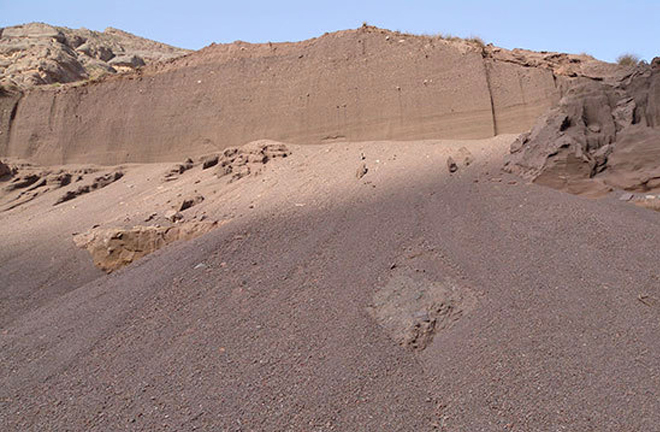Debate over flood legend, mythical dynasty reignited

The picture shows sediment from a historical flood that might have taken place in the Jishi Gorge in the upper reaches of the Yellow River.
A recent article in the US-based magazine Science has reignited the long-running academic debate over the historicity of China’s legendary past.
Published on Aug. 5, the article offered new evidence supporting the myth of the legendary hero named Yu and the Great Flood while simultaneously linking it to the founding of the Xia Dynasty.
The China-US research team led by Wu Qinglong, a geologist from the School of Geography Science at Nanjing Normal University, claimed to have found evidence for the flood in the Yellow River that is said to have been tamed by Yu, which also backs up the assertion that the Xia Dynasty existed in history.
The claim has caused a sensation in academia because it directly connects past archaeological findings about the flood legend to the founding of the Xia Dynasty, reigniting long-simmering debates over the existence of Xia and how to verify its historicity.
“The Xia Dynasty and the tales about the taming of the Great Flood are indeed real, and the establishment of the dynasty is relevant to the legend,” said Shen Changyun, a professor from the School of History and Culture at Hebei Normal University. “It was during the fight against the flood that a centralized rule began to crystallize, and Yu the Great founded the Xia Empire.”
Shen has written a number of papers probing into the legend of Yu taming the Great Flood. He agreed with part of Wu’s research, but maintained that unanswered questions remain that require further study.
Through radiocarbon dating of the human remains in a Neolithic settlement called Lajia, Wu speculated that the flood dates back to about 1920 BCE. According to historical accounts, it took 20 years for Yu and his father Gun to control the flood, so the research team deduced that the Xia Dynasty was founded around 1900 BCE.
“The research is an in-depth multidisciplinary investigation into the catastrophe in the Lajia settlement,” said Ye Maolin, a research fellow from the Institute of Archaeology at the Chinese Academy of Social Sciences and leader of an archaeological team in the settlement, adding that it is thought-provoking, but is not conclusive.
In the paper, Wu said that the timing of the critical flood coincided with the start of the so-called Erlitou culture, which is generally identified as specific to the Xia Dynasty, so the discovery can also prove that Erlitou was the Xia capital.
However, previous high-precision dating of the Erlitou culture showed that the culture came into being no earlier than 1750 BCE, so Wu’s estimate of the founding date at 1900 BCE throws that research into question.
Shen said that the Erlitou Site in Western Henan Province is in fact irrelevant to the flood and the founding of the Xia Dynasty. It was perhaps another city built during the westward expansion in the late Xia Dynasty.
Many scholars applauded Wu’s research for examining why the Lajia settlement was destroyed from geological and archaeological perspectives. Nonetheless, they called for stronger evidence to support connections with the flood in the middle reaches of the Yellow River.
Sun Hua, a professor from the School of Archaeology and Museology at Peking University, said that it is wrong to speculate about the flood in the middle Yellow River using the dating data from the upper reaches, adding that it is also wrong to calculate the dates of the Xia Dynasty by dating the flood in the Lajia settlement.
Sun expressed doubts about whether the flood could impact the middle reaches of the Yellow River. “The Lajia settlement is far away from the birthplace of the Xia culture in the middle reaches of the Yellow River. And the flood, after buffering in various widths of river courses, had become much weaker when it hit the middle reaches, so its impact was probably limited.”
In archaeological sites, flood evidence includes identifiable pure sand and silt. But at the site of the middle Yellow River, no clear evidence has ever been discovered that could attest to a great flood happening around 1920 BCE, Sun said.
In the academic debate, scholars concurred that all ancient documents, including myths and legends, are reflective of history, so they cannot be easily dismissed.
Shen suggested historians and archaeologists carefully identify and extract credible historical content from myths, legends and historical literature for research. Historical and archaeological studies are complementary and should be integrated to facilitate discussions on ancient civilizations, Shen added.
Wu Nan and Zhang Chunhai are reporters at the Chinese Social Sciences Today.
